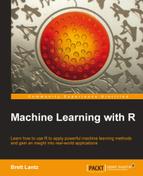This chapter presented a number of the most common measures and techniques for evaluating the performance of machine learning classification models. Although accuracy provides a simple method for examining how often a model is correct, this can be misleading in the case of rare events because the real-life cost of such events may be inversely proportional to how frequently they appear in the data.
A number of measures based on confusion matrices better capture the balance among the costs of various types of errors. Closely examining the tradeoffs between sensitivity and specificity or precision and recall can be a useful tool for thinking about the implications of errors in the real world. Visualizations such as the ROC curve are also helpful toward this end.
It is also worth mentioning that sometimes the best measure of a model's performance is to consider how well it meets or doesn't meet other objectives. For instance, you may need to explain a model's logic in simple language, which would eliminate some models from consideration. Additionally, even if it performs very well, a model that is too slow or difficult to scale to a production environment is completely useless.
An obvious extension of measuring performance is to identify automated ways to find the best models for a particular task. In the next chapter, we will build upon our work so far to investigate ways to make smarter models by systematically iterating, refining, and combining learning algorithms.
